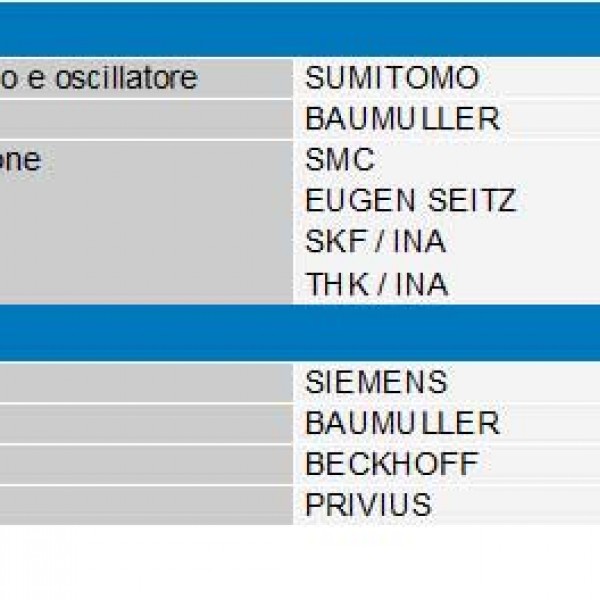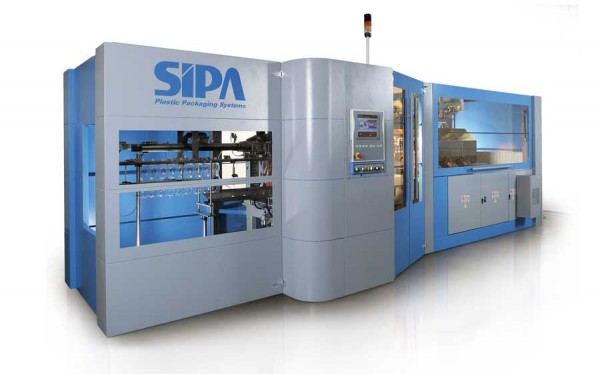Description:
DESCRIPTION OF THE SUPPLY
LINEAR BLOW MOLDING MACHINE SFL
General description
The SFL EVO is a linear blowing machine which can be equipped with 1 to 8 blowing cavities and can produce a wide range of containers.
The platform can produce standard and personalised bottles for standard filling, for hot filling, oval containers with oriented neck finish and multilayer bottles, lightweight bottles, small containers for the pharmaceutical industry as well as large containers up to 12 litres at high production rates.
Process description
Preform handling system:
The preforms for the industrial bottles production are discharged in bulk from octabins into the preform hopper; a preform octabin tilter is available as an option for standard and special preform containers.
From the hopper an elevator belt provides a continuous supply of preforms to a linear unscrambler that is located in elevated position with respect to the ovens. In the preform unscrambler two counter rotating cylinders are aligning the preforms by gravity with the neck finish upwards. So preforms are prepared to slide, always by gravity, inside the machine through an adjustable width chute that is located inside the safety housing.
Preform transfer and thermal conditioning:
From the feeding chute the preforms are loaded into the transportation chain through a loading wheel without grippers. The spindle insert gently into the perform neck finish by means of a spring which is released through a mechanical cam.
During the heating phase, performs are constantly rotated for a perfectly symmetrical distribution of heat. The ovens are ventilated in order to maintain their internal temperature at a sufficiently low level and avoid excessively high temperature on the external wall of the preforms. The ovens are designed in modules and a different number of them equip the different models according to the heating requirement.
Preforms are carried in front of (eight) 8 IR lamps on one side and mirrors having vertical slots on the other side. The ventilation air is sucked by centrifugal speed-controlled fans from underneath the ovens and then is blown perpendicularly to the preform axis. The flow is directed sequentially through mirrors slots first, preforms and lamps as last. Finally, it is exhausted from the upper part of the ovens.
Additional 9th/10th lamps, reduced pitch, increased power lamps are also available as options in order to fit special preforms.
Preforms pass through two groups of ovens, after every group there is a certain time without any heating in order to provide a proper time for stabilization of the preform temperature across the preform wall; during this time the preform does not rotate.
At the exit of the last oven the preforms are transferred to the blowing station by means of a variable pitch system operated by a servo motor, this system is able to combine the continuous motion of the preform chain with the index motion of the blowing press.
Stretch-blowing:
Stretch and blowing phase is made within a fully SERVO-DRIVEN blowing press. The blowing mould is installed with a number of cavities depending on the machine model.
The servo drive allows the press to operate with different strokes, which can be set on the HMI, in order to maximize the process time.
The axial stretching of the preforms is carried out by the stretching rods which are moving all together and are driven by a servo motor, thereby considerably increasing the repeatability and consistency of the blowing process.
The subsequent actions of low pressure air pre-blowing and further high pressure air blowing are regulated by pneumatic valves (electronically operated). The blowing parameters stored into the production recipes guarantee fast, precise and repetitive set-up of the blowing process.
During the high pressure blowing process, the opening of the mould is inhibited through a proper compensation by means of the same high pressure air.
Bottle ejection:
Once the bottle is completely formed and the blowing air is exhausted, the mould opens and the blown bottles are evacuated by a linear transfer system, which is electronically synchronized to the blowing press movement.
The machine can provide as option the downstream evacuation systems depending on the specific Customer need (air conveyor, belt conveyor, etc.).
Control software:
The human-machine interface (HMI) consists of an industrial PC. It monitors machine performances, but also manages all the parameters of heating/blowing of preforms: they are saved in the internal memory, so that each container to be produced has its own recipe.
It manage all process and operations parameters and it generates production, performances and warning/alarm reports and allows remote control operations.
The HMI also monitors and suggests machines maintenance activities. All process parameters for preforms heating and bottle blowing can be edited through the HMI interface and can be stored into the machine data storage system (UPS), even in case of black-out.
Air Recovery system (ARS®)
ARS® system recovers the air released by each cavity in a dedicated tank (integrated in the machine) and re-circulate it where needed (pre-blow air, service air etc).
ARS+® recovers much more air in two different tanks: the first one (low pressure) is used for pre-blow, the secondo one (medium pressure) is used for intermediate blow, before final high-pressure blowing
Due to that, the compressor has to supply just the final need of air (18-28 bar).
Both these systems are optional.




